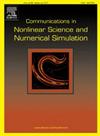Phase-field modeling of fiber-based thermal diffusion and phase transitions in the fused deposition modeling process
IF 3.4
2区 数学
Q1 MATHEMATICS, APPLIED
Communications in Nonlinear Science and Numerical Simulation
Pub Date : 2025-06-27
DOI:10.1016/j.cnsns.2025.109071
引用次数: 0
Abstract
This paper introduces an advanced phase-field equation designed to accurately simulate solid–liquid phase transitions and thermal transport during the fused deposition modeling procedure. The model incorporates bidirectional coupling between phase transitions and thermal diffusion, which allows for precise predictions of temperature distribution and detailed tracking of phase evolution influenced by temperature changes. Additionally, it dynamically accounts for the moving heat source in fused deposition modeling by integrating a temperature field that evolves with nozzle movement. To further enhance heat transfer accuracy, a heat convection term combined with the nozzle velocity field is introduced. The proposed algorithm ensures consistency between the digital simulation environment and real-world physical quantities. This consistency provides a highly realistic representation of the fused deposition modeling process. This approach enables effective simulation of temperature distribution and the resulting changes in the geometry and structure of printed parts. It also supports the prediction and optimization of part quality and output in additive manufacturing.
熔融沉积过程中基于纤维的热扩散和相变相场建模
本文介绍了一种先进的相场方程,用于精确模拟熔融沉积建模过程中的固液相变和热输运。该模型结合了相变和热扩散之间的双向耦合,可以精确预测温度分布,并详细跟踪受温度变化影响的相演变。此外,它还通过集成随着喷嘴运动而变化的温度场来动态地解释熔融沉积模型中移动的热源。为了进一步提高传热精度,引入了与喷嘴速度场相结合的热对流项。该算法保证了数字仿真环境与实际物理量的一致性。这种一致性为熔融沉积建模过程提供了高度逼真的表示。这种方法可以有效地模拟温度分布和打印部件的几何形状和结构的变化。它还支持增材制造中零件质量和产量的预测和优化。
本文章由计算机程序翻译,如有差异,请以英文原文为准。
求助全文
约1分钟内获得全文
求助全文
来源期刊

Communications in Nonlinear Science and Numerical Simulation
MATHEMATICS, APPLIED-MATHEMATICS, INTERDISCIPLINARY APPLICATIONS
CiteScore
6.80
自引率
7.70%
发文量
378
审稿时长
78 days
期刊介绍:
The journal publishes original research findings on experimental observation, mathematical modeling, theoretical analysis and numerical simulation, for more accurate description, better prediction or novel application, of nonlinear phenomena in science and engineering. It offers a venue for researchers to make rapid exchange of ideas and techniques in nonlinear science and complexity.
The submission of manuscripts with cross-disciplinary approaches in nonlinear science and complexity is particularly encouraged.
Topics of interest:
Nonlinear differential or delay equations, Lie group analysis and asymptotic methods, Discontinuous systems, Fractals, Fractional calculus and dynamics, Nonlinear effects in quantum mechanics, Nonlinear stochastic processes, Experimental nonlinear science, Time-series and signal analysis, Computational methods and simulations in nonlinear science and engineering, Control of dynamical systems, Synchronization, Lyapunov analysis, High-dimensional chaos and turbulence, Chaos in Hamiltonian systems, Integrable systems and solitons, Collective behavior in many-body systems, Biological physics and networks, Nonlinear mechanical systems, Complex systems and complexity.
No length limitation for contributions is set, but only concisely written manuscripts are published. Brief papers are published on the basis of Rapid Communications. Discussions of previously published papers are welcome.
 求助内容:
求助内容: 应助结果提醒方式:
应助结果提醒方式:


